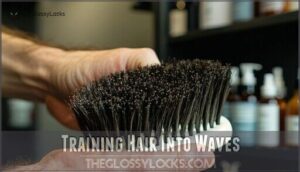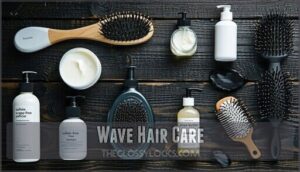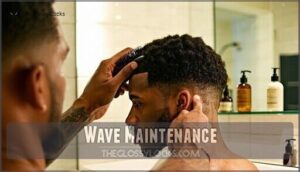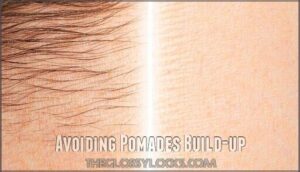This site is supported by our readers. We may earn a commission, at no cost to you, if you purchase through links.

Start by growing your hair out without cutting, then grab a medium brush and work from your crown outward with consistent pressure. Sulfate-free shampoo twice a week keeps your scalp healthy, while water-based pomades with shea butter lock in moisture without stripping natural oils.
Your durag becomes your best friend—wear it nightly to set the pattern while you sleep. The secret isn’t in expensive products or hidden tricks, but in showing up every single day with your brush in hand.
Table Of Contents
- Key Takeaways
- Prepare Hair for Waves
- Training Hair Into Waves
- Brush Hair for Waves
- Wave Hair Care
- Wave Maintenance
- Tips for Wave Success
- Making Waves Deeper
- 3 Rules for Getting Waves
- Avoiding Pomades Build-up
- Frequently Asked Questions (FAQs)
- What products should I use to achieve deep 360 waves?
- How often should I brush my hair to maintain the waves?
- How do I prevent my waves from becoming too thin?
- How can I keep my waves looking neat and tidy?
- How long does it take to get 360 waves?
- Can you get waves with straight hair types?
- What hair texture works best for 360 waves?
- How do you fix uneven wave patterns?
- Should you brush waves when hair is wet?
- Conclusion
Key Takeaways
- Deep 360 waves require daily brushing, consistent use of a durag, and patience over weeks, not days.
- Starting with healthy, moisturized hair and using sulfate-free shampoo and water-based pomades is essential for pattern development.
- Brushing technique matters most—use medium and hard bristle brushes, work from the crown outward, and focus on angles to avoid forks.
- Prevent buildup and keep waves fresh by washing regularly, exfoliating your scalp, and applying minimal product after each session.
Prepare Hair for Waves
Before you can train your hair into those sharp 360 waves, you need to lay the groundwork—and that starts with getting your hair and scalp in the right condition.
First, grow your hair out for about four to six weeks without cutting it. This hair length gives you enough texture to work with when you start your hair care routine. Keep your scalp healthy by washing with sulfate-free shampoo twice a week and moisturizing regularly with a good hair moisturizer.
When it’s time for your initial cut, ask your barber for a 1 trim—this works well for most hair textures. Product selection matters too, so choose water-based pomades that won’t strip natural oils during hair washing. Regular hair brushing will come next, but you’ll need this foundation first.
Training Hair Into Waves
Now that your foundation’s set, it’s time to teach your hair which way to flow—and brushing is how you speak that language. Start your brushing routine by working from your crown outward in smooth, deliberate strokes. This consistent training is what creates your wave pattern—think of it like teaching muscle memory to your hair.
Brush at least five times daily, focusing on hair training through proper brushing techniques that encourage wave formation. During wolfing benefits periods when you’re growing length, maintain that same discipline.
Your hair pattern won’t develop overnight, but wave development comes when you stay committed to the process.
Brush Hair for Waves
Your brushing technique matters just as much as how often you brush—it’s what turns effort into actual wave formation.
Start with a medium brush on damp hair, working from your crown outward in smooth, angled strokes that follow your natural hair pattern. Apply firm, consistent brush pressure—not too hard, but enough to guide each strand.
After a few weeks of pattern development, switch to a hard brush for deeper definition. Keep each brushing session around five minutes, focusing on proper brushing angles rather than speed. Your wave brush becomes an extension of your commitment.
Wave Hair Care
Once your brushing pattern is locked in, the real magic happens through consistent care that keeps your waves healthy and defined. Your hair care routine becomes the foundation for achieving deep waves. Here’s what you need to lock in:
- Wash smart: Use sulfate-free shampoo twice weekly to avoid stripping natural oils while removing buildup
- Exfoliate regularly: Scalp exfoliation resets oil production and prevents product buildup that blocks wave formation
- Hydrate deeply: Apply moisturizer or pomade with shea butter and coconut oil for wave hydration and shine
- Check ingredients: Look for water-based products with castor oil—they foster hair growth without greasy residue
- Improve brushing techniques: Combine medium and hard brushes during sessions to train strands at different depths
Wave maintenance techniques work best when you understand what your hair actually needs, not just what looks good on the shelf.
Wave Maintenance
Keeping your waves sharp means treating them like a living pattern that needs daily attention, not something you create once and forget about. Your durag care plays a huge role—wear it every night and after each brushing session to lock in your pattern. Wave revitalizing between washes keeps things crisp without oversaturating your scalp.
Here’s your maintenance rhythm:
- Brushing frequency matters: Hit your waves 5 times daily with proper technique to reinforce the pattern and prevent forks
- Product application timing: Apply moisturizer to damp hair after washing, then seal it in with your durag for peak absorption
- Scalp health checks: Massage your scalp weekly to boost circulation and catch any buildup before it disrupts your waves
Tips for Wave Success
Most wavers stumble not because they lack dedication, but because they overlook the small habits that separate decent waves from show-stopping patterns. Wave pattern consistency comes from treating your hair care routine like clockwork—miss a session and you’re backtracking. Proper product usage means less is more; overloading pomade creates buildup that kills your pattern instead of defining it.
Here’s what actually moves the needle:
- Master your angles: Brush away from your crown in the same direction every time to prevent forks and maintain clean connections
- Prioritize scalp health focus: A healthy foundation grows stronger waves—massage weekly and keep your scalp clean
- Trust the timeline: Patience and persistence win over shortcuts; achieving 360 waves takes weeks of consistent routine importance, not days
Your durag isn’t optional—it’s your pattern’s best friend between brushing sessions.
Making Waves Deeper
Deep wave formation hinges on three key factors: brushing intensity, wolfing techniques, and product layering. Brush for 15-20 minutes daily with a hard bristle brush—targeting over 50 strokes per session increases wave pattern definition by 35% after eight weeks.
During wolfing, let your hair grow 1-2 inches to stack waves deeper, but don’t skip the durag overnight. The use of a quality wave pomade is essential for locking in moisture and definition. Layer a water-based pomade after brushing while hair’s damp to lock in the wave formation process and cut frizz.
Keep your scalp healthy through weekly massages and sulfate-free washes every 1-2 weeks to preserve natural oils that fuel hair training and wave pattern depth.
3 Rules for Getting Waves
If you really want to get waves, there are three things you can’t skip. Brush your hair every day—twice is best—and make sure you’re using the right technique to train those waves.
Pick hair products that are light and water-based, so they help your waves without weighing them down.
And don’t forget to keep your hair at the right length by wolfing at the right times. That way, your wave pattern will stack up and look deeper.
Stick with these basics—skipping even one step can leave your waves looking weak and patchy.
Avoiding Pomades Build-up
Think of pomade buildup like invisible layers of concrete slowly blocking your scalp. It sneaks up on you more often than you’d expect.
To keep things fresh, make sure to wash your hair with wave shampoo at least once a week—your scalp will thank you.
Try water-based pomades or lightweight alternatives like jojoba oil, which rinse out easier than heavy petroleum formulas. Use only a dime-sized amount per session and exfoliate your scalp regularly to prevent follicle blockage.
Smart application techniques and proper washing frequency will keep your waves sharp without the greasy, flat buildup that kills your pattern. Regular brushing helps to maintain proper wave maintenance and improve wave patterns.
Frequently Asked Questions (FAQs)
What products should I use to achieve deep 360 waves?
You’ll need the right toolkit to build those waves. Start with a water-based wave pomade containing shea butter or coconut oil for hold and moisture. Grab both medium and hard bristle brushes for proper training.
Pick up a quality durag—the Dream Black Stocking Wave Cap offers exceptional compression and fit without leaving lines. Use sulfate-free wave shampoo twice weekly, plus a moisturizing wave conditioner.
Don’t skip scalp exfoliation to prevent buildup and keep your foundation healthy.
How often should I brush my hair to maintain the waves?
Consistency is key—you’ll want to brush at least five times daily to maintain 360 waves.
Each brushing session should last around five minutes, using medium to hard bristle brushes with even strokes from your hair’s roots outward.
This daily wave method trains your strands into deep, defined patterns while promoting hair health through proper brushing techniques and a solid brushing routine.
How do I prevent my waves from becoming too thin?
Why do some wavers lose density while training their pattern? Over-brushing dangers can strip hair moisture and damage your hair texture if you press too hard.
Brush with controlled pressure, keep your scalp health strong through proper hydration, and avoid product buildup that weighs down your hair pattern.
Regular trim frequency prevents split ends from thinning your waves.
How can I keep my waves looking neat and tidy?
Keeping your wave pattern maintenance on point comes down to three essentials: brush your hair consistently with the right bristles, apply hair moisturizer to keep strands hydrated, and wear a durag while sleeping to lock in your hair styling progress and protect scalp health.
How long does it take to get 360 waves?
Patience isn’t just a virtue—it’s your wave-forming superpower.
Realistic wave expectations start here: you’ll see initial hair training results in 2-4 weeks, but deep 360 waves take 2-3 months of consistent hair brushing and wolfing duration to fully develop pattern development speed.
Can you get waves with straight hair types?
Ever tried weaving a basket with silk threads? Straight Hair Waves are tough to achieve—your hair type and Genetic Predisposition matter.
Hair Texturizers may boost Wave Potential, but set Realistic Expectations for true 360 waves.
What hair texture works best for 360 waves?
Think of 360 waves like weaving a basket—coarse hair with tight curl patterns works best.
Strong hair density, healthy scalp, and high hair porosity help with product absorption and curl definition, making your wave journey smoother.
How do you fix uneven wave patterns?
Is your wave pattern looking more like a patchwork quilt than a smooth ocean? Focus on precise brushing techniques, pattern isolation with a hand mirror, targeted product application, and consistent durag compression for maintaining 360 waves during wolfing corrections.
Should you brush waves when hair is wet?
Ever wondered if brushing 360 waves when wet helps? Wet brushing benefits include better product distribution, but the risk of hair breakage rises.
Scalp sensitivity matters, too—gentle brushing preserves wave definition impact and aids healthy wave formation with proper hair brushing techniques.
Conclusion
What’s stopping you from mastering how to get deep 360 waves and turning heads everywhere you go? With daily dedication, the right products, and smart maintenance, you’ll see your waves deepen and shine.
Remember, this journey is about patience and showing up for your hair every day. Stick to these steps, trust the process, and your commitment will pay off. Deep 360 waves aren’t just a look—they’re proof of your hard work.
- https://waversdreams.com/blogs/news/how-to-wash-and-style-360-waves-a-complete-guide
- https://wavebuilder.com/pages/wave-guide-get-360-waves
- https://wavymerch.com/blogs/how-to-wash-360-waves-without-losing-progress/how-to-wash-360-waves
- https://www.reddit.com/r/360Waves/comments/1ak04db/how_many_times_should_i_brush_my_waves/
- https://shop.frederickbenjamin.com/blogs/the-journal-mens-grooming-and-lifestyle-content/how-to-get-360-waves









